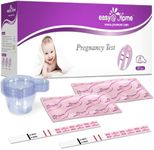Buying Guide for the Best Pregnancy Tests
Choosing the right pregnancy test can feel overwhelming with so many options available, but understanding the key features can help you make a confident decision. Pregnancy tests are designed to detect the presence of the hormone hCG in urine, which is an early indicator of pregnancy. When picking a test, it's important to consider how soon you want results, how easy the test is to use and read, and your personal preferences for convenience and privacy. By focusing on the main specifications, you can find a test that fits your needs and gives you reliable results.Sensitivity (hCG Detection Level)Sensitivity refers to the lowest amount of the pregnancy hormone (hCG) that the test can detect, usually measured in milli-international units per milliliter (mIU/mL). A lower number means the test can detect pregnancy earlier, sometimes even before a missed period. Tests with higher sensitivity (10-20 mIU/mL) are best if you want to test as early as possible, while those with lower sensitivity (25-50 mIU/mL) are suitable if you can wait until after your missed period. If early detection is important to you, look for a test with a lower hCG detection level.
Result Display TypePregnancy tests can show results in different ways, such as lines, plus/minus symbols, or digital words like 'pregnant' or 'not pregnant.' Line tests are usually less expensive but can sometimes be harder to interpret, especially if the line is faint. Digital tests are easier to read and reduce confusion, but they may cost more. If you want a clear, straightforward answer, a digital display might be best, while those comfortable with reading lines can choose a traditional test.
Testing MethodThere are two main ways to use a pregnancy test: midstream (holding the stick in your urine stream) or dip tests (dipping the test strip into a collected urine sample). Midstream tests are more convenient and less messy, while dip tests are often more affordable and come in multi-packs. If you value convenience and ease, a midstream test is a good choice. If you prefer to test multiple times or want to save, dip tests might be better.
Time to ResultsThis refers to how quickly the test will show your result, usually ranging from one to five minutes. Faster tests are helpful if you want immediate answers, while others may take a bit longer but are just as accurate. If you are anxious or in a hurry, look for a test that promises results in one to two minutes. If waiting a few extra minutes is not an issue, this spec may be less important.
Ease of UseSome tests are designed with features like ergonomic handles, wider tips, or clear instructions to make the process easier and less stressful. If you are new to using pregnancy tests or want a simple experience, look for tests that highlight user-friendly features. If you are comfortable with the process, you may not need these extras.
Result Window SizeThe size of the result window can affect how easily you can read the outcome. Larger windows make it easier to see the result, which is helpful if you have vision difficulties or want to avoid misreading. If clarity is important to you, choose a test with a larger result window.














